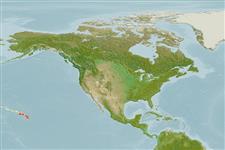Actinopterygii (ray-finned fishes) >
Pleuronectiformes (Flatfishes) >
Soleidae (Soles)
Etymology: Aseraggodes: Greek, aggos, -eos, -ous = vessel, uterus, carapace of a crab + Greek, aseros, -a, -on = to remove the appetite (Ref. 45335). More on author: Randall.
Environment / Climate / Range
Ecology
Marine; demersal; depth range 2 - 26 m (Ref. 13070). Tropical, preferred ?
Eastern Central Pacific: Hawaiian Islands.
Size / Weight / Age
Maturity: Lm ? range ? - ? cm
Max length : 6.6 cm SL male/unsexed; (Ref. 13070); 5.5 cm SL (female)
Short description
Morphology | Morphometrics
Anal
soft rays: 54 - 61. Caudal peduncle absent. Dorsal- and anal-fin rays with a broad, membranous ridge extending from base of each ray and gradually narrowing to ray tip. Ocular side with prominent dark blotches in 3 rows; the middle one with just 2 blotches, the largest and darkest (Ref. 48239).
Benthic on sand, rubble or reef (Ref. 58302). Often buried in sand in caves. Feeds on small crustaceans (shrimps, crabs, isopods, ostracods, and amphipods, caprellids (Ref. 13070).
Life cycle and mating behavior
Maturity | Reproduction | Spawning | Eggs | Fecundity | Larvae
Randall, J.E., 1996. Two new soles of the genus Aseraggodes (Pleuronectiformes: Soleidae) from the Hawaiian Islands. Pac. Sci. 50(4):427-440. (Ref. 13070)
IUCN Red List Status (Ref. 115185)
CITES (Ref. 94142)
Not Evaluated
Threat to humans
Harmless
Human uses
More information
Common namesSynonymsMetabolismPredatorsEcotoxicologyReproductionMaturitySpawningFecundityEggsEgg development
Age/SizeGrowthLength-weightLength-lengthLength-frequenciesMorphometricsMorphologyLarvaeLarval dynamicsRecruitmentAbundance
ReferencesAquacultureAquaculture profileStrainsGeneticsAllele frequenciesHeritabilityDiseasesProcessingMass conversion
Tools
Special reports
Download XML
Internet sources
